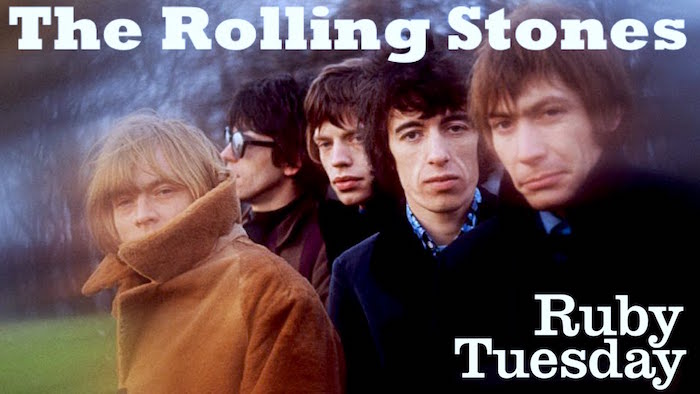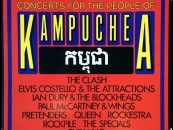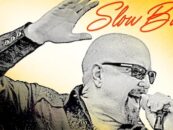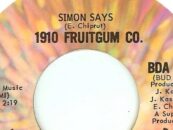Revisiting the Rolling Stones’ ‘Ruby Tuesday’
by Best Classic Bands Staff
In 2016, ABKCO Records released a massive box set including all of the studio albums released in mono by the Rolling Stones in the 1960s. The Rolling Stones in Mono, available in both 15-CD and 16-LP vinyl configurations, as well as Standard Digital, Mastered for iTunes and True HD (96k/24 bit, 192k/24 bit and DSD), contains a total of 186 tracks, 56 of which had never before been heard in mono since the advent of the digital age, according to the original announcement from the label, which retains the rights to the Stones’ early recordings.
Fast forward to May 22, 2018, and ABKCO released an official lyric video for the group’s 1967 smash hit, “Ruby Tuesday,” to coincide with the Stones’ 2018 #NoFilter tour of the U.K. and Europe.
From the announcement: “For this hauntingly beautiful ballad the goal was to create a romantic and evocative visual inspired by 60s design and an independent, free-spirited woman. To enhance the wistful, baroque feel of the verses, densely decorative floral and paisley patterns which form throughout each scene create a rich tapestry of detail. The choruses cut to kaleidoscopic patterns set against a bright ruby red backdrop, ensuring a big hit of colour in contrast to the verses.”
The Rolling Stones in Mono covers the formative years of 1963-69 featuring hits like “(I Can’t Get No) Satisfaction,” “Get Off Of My Cloud,” “19th Nervous Breakdown” and “Paint it Black,” to name a few. The idea behind releasing the collection, the 2016 press release explained, is that, “Most rock and pop recordings were originally recorded in mono, with stereo often an afterthought, dealt with only following the completion of the original (mono) version of a given track.”
In addition to the Stones’ original albums from this period, some in both their U.K. and U.S. configurations, the collection includes an additional disc – Stray Cats – of single and EP tracks from the ’60s.
Recording engineer Dave Hassinger, who worked with the Stones from 1964-66, explained how he mixed the Stones in mono: “They always played together at the same time,” he is quoted as saying. “They would run the parts down, work out the changes here and there, nail it down, then start recording.”
ABKCO’s Chief Audio Engineer, Teri Landi, told Best Classic Bands: “The source tapes for this project were generally in excellent shape. These are magnetic tapes that are 50 years old (plus or minus a few years) so, that is quite remarkable.” A colored-vinyl edition was released in 2023.
Related: Our interview: Behind the Mono Boxed Set
More on “Ruby Tuesday” from the announcement: “The song was written, for the most part, by Stones guitarist Keith Richards in 1966, inspired by Linda Keith, his girlfriend at the time, who had recently left him for a poet named Bill Chenail; soon thereafter she began dating rising star Jimi Hendrix.” “That’s the first time I felt the deep cut,” Richards recollected in his 2010 autobiography Life. “The thing about being a songwriter is, even if you’ve been f*cked over, you can find consolation in writing about it, and pour it out . . . It becomes an experience, a feeling, or a conglomeration of experiences. Basically Linda is ‘Ruby Tuesday.’”
The recording features Brian Jones on recorder, Bill Wyman fretting a double bass (with Keith Richards bowing it) and outside help from arranger/composer Jack Nitzsche who played piano on the track. Initially released in January 1967 as a B-side to “Let’s Spend the Night Together,” radio station programmers avoided the A-side due to its controversial lyrics, and “Ruby Tuesday” became the Rolling Stones’ fourth #1 U.S. hit that March 4th, and got to #3 in the U.K.
The recording is included on a 2024 collection, The Rolling Stones Singles 1966-1971, available for order in the U.S. here and the U.K. here.
Related: The London bar scene of the early Rolling Stones
Watch the Stones perform the song on the 2021 edition of their “No Filter” tour






4 Comments so far
Jump into a conversationTHE STONES MONO ALBUMS WILL BE LIKE THE OLD DAYS CRUISIN’ THE AVE.
Stereo sounds so much better. The Stones need to release all their early stuff in stereo. It sounds so much better. The Beatles and Beach Boys did so why not the stones? While we’re at it: The Stones need to release official Live recordings of the Mick Taylor era from 1969-1973. These are the best years from the Stones. Open the vault!
Some of the Stones early recordings can be found in stereo.
There’s “Rarities on Compact Disc #20”, one of a series of terrific promo/radio-station-only discs issued by Westwood One in the 1990s, back when record companies finally figured thar’s gold in them there vaults.
Also, the German “Hot Rocks” from the 1990s had some songs in stereo, as did a number of Japanese releases.
The purchases of Louisiana and Alaska might have been the greatest bargains in history. Allen Klein’s nabbing of the Stones’ 60s output (and Brown Sugar to boot) for a relative pittance isn’t far behind.
In late 1966, I was just starting to transition out of my I-hate-any-record-with-Mick-Jagger’s-voice-on-it phase. When “Let’s Spend the Night Together” came out, I kinda liked it (it was almost funny).
But it was not easy to hear in Northeastern Pennsylvania and my Top 40 station (WARM, the Mighty 590) was not given to prudery and “banning” records.
I have long imagined that the Stones and their management—who, in 1967, was the wily and pugnacious Andrew Loog Oldham—pretty much knew that such a side was going to create some controversy and meet some obstacles with the BBC in the UK and possibly be “banned” outright on many radio stations in the US.
Had the lyrics merely been about two teenagers staying up late together to study for their final exams, the title alone would still have raised some hackles among un-hip (non-woke?) station owners and radio programmers.
So, how to overcome those obstacles?
Easy—just couple the suggestive side with a strong flip-side that doesn’t insinuate sexual activity or illegal drug use. And if that flip-side was an even better recording than the controversial one, then all will be well and good despite the prudes and censors.
(Just to make certain this was understood, in the UK, Decca shipped promotional copies with both sides of the record designated as the “A” side.)
Personally, “Ruby Tuesday” went a long way in helping me overcome my distaste for Mick’s voice, and the next single, “We Love You” / “Dandelion” went even further.
With the THEIR SATANIC MAJESTIES REQUEST album, I became a convert (and a bit of a proselytizing one, at that.)